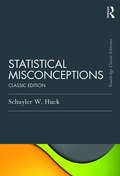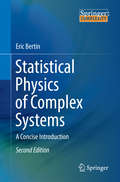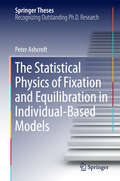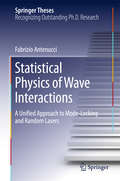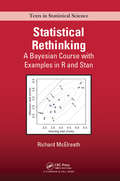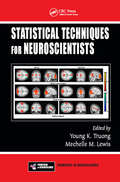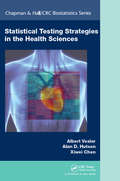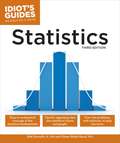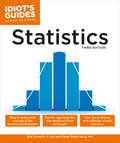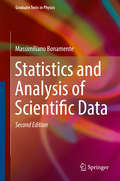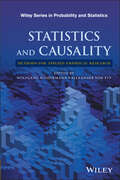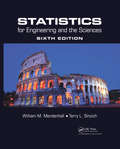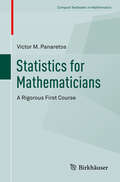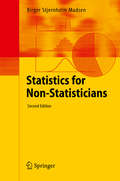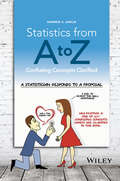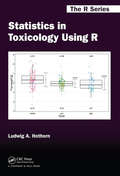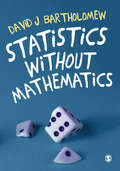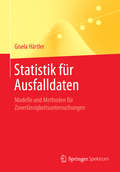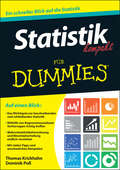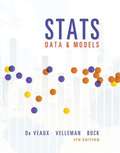- Table View
- List View
Statistical Methodologies with Medical Applications
by Poduri Srs RaoThis book presents the methodology and applications of a range of important topics in statistics, and is designed for graduate students in Statistics and Biostatistics and for medical researchers. Illustrations and more than ninety exercises with solutions are presented. They are constructed from the research findings of the medical journals, summary reports of the Centre for Disease Control (CDC) and the World Health Organization (WHO), and practical situations. The illustrations and exercises are related to topics such as immunization, obesity, hypertension, lipid levels, diet and exercise, harmful effects of smoking and air pollution, and the benefits of gluten free diet. This book can be recommended for a one or two semester graduate level course for students studying Statistics, Biostatistics, Epidemiology and Health Sciences. It will also be useful as a companion for medical researchers and research oriented physicians.
Statistical Misconceptions: Classic Edition (Psychology Press & Routledge Classic Editions)
by Schuyler W. HuckThis engaging book helps readers identify and then discard 52 misconceptions about data and statistical summaries. The focus is on major concepts contained in typical undergraduate and graduate courses in statistics, research methods, or quantitative analysis. Interactive Internet exercises that further promote undoing the misconceptions are found on the book's website. The author’s accessible discussion of each misconception has five parts: The Misconception - a brief description of the misunderstanding Evidence that the Misconception Exists – examples and claimed prevalence Why the Misconception is Dangerous – consequence of having the misunderstanding Undoing the Misconception - how to think correctly about the concept Internet Assignment - an interactive activity to help readers gain a firm grasp of the statistical concept and overcome the misconception. The book's statistical misconceptions are grouped into 12 chapters that match the topics typically taught in introductory/intermediate courses. However, each of the 52 discussions is self-contained, thus allowing the misconceptions to be covered in any order without confusing the reader. Organized and presented in this manner, the book is an ideal supplement for any standard textbook. An ideal supplement for undergraduate and graduate courses in statistics, research methods, or quantitative analysis taught in psychology, education, business, nursing, medicine, and the social sciences. The book also appeals to independent researchers interested in undoing their statistical misconceptions.
Statistical Physics of Complex Systems
by Eric BertinThis course-tested primer provides graduate students and non-specialists with a basic understanding of the concepts and methods of statistical physics and demonstrates their wide range of applications to interdisciplinary topics in the field of complex system sciences, including selected aspects of theoretical modeling in biology and the social sciences. Generally speaking, the goals of statistical physics may be summarized as follows: on the one hand to study systems composed of a large number of interacting units, and on the other to predict the macroscopic, collective behavior of the system considered from the perspective of the microscopic laws governing the dynamics of the individual entities. These two goals are essentially also shared by what is now called 'complex systems science,' and as such, systems studied in the framework of statistical physics may be considered to be among the simplest examples of complex systems - while also offering a rather well developed mathematical treatment. The second edition has been significantly revised and expanded, featuring in particular three new chapters addressing non-conserved particles, evolutionary population dynamics, networks, properties of both individual and coupled simple dynamical systems, and convergence theorems, as well as short appendices that offer helpful hints on how to perform simple stochastic simulations in practice. Yet, the original spirit of the book - to remain accessible to a broad, non-specialized readership - has been kept throughout: the format is a set of concise, modular and self-contained topical chapters, avoiding technicalities and jargon as much as possible, and complemented by a wealth of worked-out examples, so as to make this work useful as a self-study text or as textbook for short courses. From the reviews of the first edition: ". . . a good introduction to basic concepts of statistical physics and complex systems for students and researchers with an interest in complex systems in other fields . . . . " Georg Hebermehl, Zentralblatt MATH, Vol. 1237, 2012 ". . . this short text remains very refreshing for the mathematician. " Dimitri Petritis, Mathematical Reviews, Issue 2012k
The Statistical Physics of Fixation and Equilibration in Individual-Based Models
by Peter AshcroftThis thesis explores several interdisciplinary topics at the border of theoretical physics and biology, presenting results that demonstrate the power of methods from statistical physics when applied to neighbouring disciplines. From birth-death processes in switching environments to discussions on the meaning of quasi-potential landscapes in high-dimensional spaces, this thesis is a shining example of the efficacy of interdisciplinary research. The fields advanced in this work include game theory, the dynamics of cancer, and invasion of mutants in resident populations, as well as general contributions to the theory of stochastic processes. The background material provides an intuitive introduction to the theory and applications of stochastic population dynamics, and the use of techniques from statistical physics in their analysis. The thesis then builds on these foundations to address problems motivated by biological phenomena.
Statistical Physics of Wave Interactions
by Fabrizio AntenucciThis thesis reveals the utility of pursuing a statistical physics approach in the description of wave interactions in multimode optical systems. To that end, the appropriate Hamiltonian models are derived and their limits of applicability are discussed. The versatility of the framework allows the characterization of ordered and disordered lasers in open and closed cavities in a unified scheme, from standard mode-locking to random lasers. With the use of replica method and Monte Carlo simulations, the models are categorized on the basis of universal properties, and nontrivial predictions of experimental relevance are obtained. In particular, the approach makes it possible to nonperturbatively treat the interplay between disorder and nonlinearity and to envisage novel and fascinating physical phenomena such as glassy random lasers, providing a novel way to experimentally investigate replica symmetry breaking.
Statistical Rethinking: A Bayesian Course with Examples in R and Stan (Chapman & Hall/CRC Texts in Statistical Science #122)
by Richard McElreath<p>Statistical Rethinking: A Bayesian Course with Examples in R and Stan builds readers’ knowledge of and confidence in statistical modeling. Reflecting the need for even minor programming in today’s model-based statistics, the book pushes readers to perform step-by-step calculations that are usually automated. This unique computational approach ensures that readers understand enough of the details to make reasonable choices and interpretations in their own modeling work. <p>The text presents generalized linear multilevel models from a Bayesian perspective, relying on a simple logical interpretation of Bayesian probability and maximum entropy. It covers from the basics of regression to multilevel models. The author also discusses measurement error, missing data, and Gaussian process models for spatial and network autocorrelation. <p>By using complete R code examples throughout, this book provides a practical foundation for performing statistical inference. Designed for both PhD students and seasoned professionals in the natural and social sciences, it prepares them for more advanced or specialized statistical modeling. </p>
Statistical Shape Analysis: with applications in R
by Ian L. Dryden Kanti V. MardiaA thoroughly revised and updated edition of this introduction to modern statistical methods for shape analysis Shape analysis is an important tool in the many disciplines where objects are compared using geometrical features. Examples include comparing brain shape in schizophrenia; investigating protein molecules in bioinformatics; and describing growth of organisms in biology. This book is a significant update of the highly-regarded `Statistical Shape Analysis' by the same authors. The new edition lays the foundations of landmark shape analysis, including geometrical concepts and statistical techniques, and extends to include analysis of curves, surfaces, images and other types of object data. Key definitions and concepts are discussed throughout, and the relative merits of different approaches are presented. The authors have included substantial new material on recent statistical developments and offer numerous examples throughout the text. Concepts are introduced in an accessible manner, while retaining sufficient detail for more specialist statisticians to appreciate the challenges and opportunities of this new field. Computer code has been included for instructional use, along with exercises to enable readers to implement the applications themselves in R and to follow the key ideas by hands-on analysis. Statistical Shape Analysis: with Applications in R will offer a valuable introduction to this fast-moving research area for statisticians and other applied scientists working in diverse areas, including archaeology, bioinformatics, biology, chemistry, computer science, medicine, morphometics and image analysis .
Statistical Techniques for Neuroscientists (Foundations and Innovations in Neurobiology)
by Young K. Truong Mechelle M. LewisStatistical Techniques for Neuroscientists introduces new and useful methods for data analysis involving simultaneous recording of neuron or large cluster (brain region) neuron activity. The statistical estimation and tests of hypotheses are based on the likelihood principle derived from stationary point processes and time series. Algorithms and software development are given in each chapter to reproduce the computer simulated results described therein. The book examines current statistical methods for solving emerging problems in neuroscience. These methods have been applied to data involving multichannel neural spike train, spike sorting, blind source separation, functional and effective neural connectivity, spatiotemporal modeling, and multimodal neuroimaging techniques. The author provides an overview of various methods being applied to specific research areas of neuroscience, emphasizing statistical principles and their software. The book includes examples and experimental data so that readers can understand the principles and master the methods. The first part of the book deals with the traditional multivariate time series analysis applied to the context of multichannel spike trains and fMRI using respectively the probability structures or likelihood associated with time-to-fire and discrete Fourier transforms (DFT) of point processes. The second part introduces a relatively new form of statistical spatiotemporal modeling for fMRI and EEG data analysis. In addition to neural scientists and statisticians, anyone wishing to employ intense computing methods to extract important features and information directly from data rather than relying heavily on models built on leading cases such as linear regression or Gaussian processes will find this book extremely helpful.
Statistical Testing Strategies in the Health Sciences (Chapman & Hall/CRC Biostatistics Series)
by Albert Vexler Alan D. Hutson Xiwei ChenStatistical Testing Strategies in the Health Sciences provides a compendium of statistical approaches for decision making, ranging from graphical methods and classical procedures through computationally intensive bootstrap strategies to advanced empirical likelihood techniques. It bridges the gap between theoretical statistical methods and practical procedures applied to the planning and analysis of health-related experiments. The book is organized primarily based on the type of questions to be answered by inference procedures or according to the general type of mathematical derivation. It establishes the theoretical framework for each method, with a substantial amount of chapter notes included for additional reference. It then focuses on the practical application for each concept, providing real-world examples that can be easily implemented using corresponding statistical software code in R and SAS. The book also explains the basic elements and methods for constructing correct and powerful statistical decision-making processes to be adapted for complex statistical applications. With techniques spanning robust statistical methods to more computationally intensive approaches, this book shows how to apply correct and efficient testing mechanisms to various problems encountered in medical and epidemiological studies, including clinical trials. Theoretical statisticians, medical researchers, and other practitioners in epidemiology and clinical research will appreciate the book’s novel theoretical and applied results. The book is also suitable for graduate students in biostatistics, epidemiology, health-related sciences, and areas pertaining to formal decision-making mechanisms.
Statistics
by Robert A. Donnelly Fatma Abdel-RaoufStatistics is a class that is required in many college majors, and it's an increasingly popular Advanced Placement (AP) high school course. In addition to math and technical students, many business and liberal arts students are required to take it as a fundamental component of their majors. A knowledge of statistical interpretation is vital for many careers. Idiot's Guides(R) Statistics explains the fundamental tenets in language anyone can understand.
Statistics, 3E (Idiot's Guides)
by Robert A. Donnelly Fatma Abdel-RaoufStatistics is a class that is required in many college majors, and it&’s an increasingly popular Advanced Placement (AP) high school course. In addition to math and technical students, many business and liberal arts students are required to take it as a fundamental component of their majors. A knowledge of statistical interpretation is vital for many careers. Idiot&’s Guides®: Statistics explains the fundamental tenets in language anyone can understand. Content includes: - Calculating descriptive statistics. - Measures of central tendency: mean, median, and mode. - Probability. - Variance analysis. - Inferential statistics. - Hypothesis testing. - Organizing data into statistical charts and tables.
Statistics and Analysis of Scientific Data
by Massimiliano BonamenteThe revised second edition of this textbook provides the reader with a solid foundation in probability theory and statistics as applied to the physical sciences, engineering and related fields. It covers a broad range of numerical and analytical methods that are essential for the correct analysis of scientific data, including probability theory, distribution functions of statistics, fits to two-dimensional data and parameter estimation, Monte Carlo methods and Markov chains. Features new to this edition include: * a discussion of statistical techniques employed in business science, such as multiple regression analysis of multivariate datasets. * a new chapter on the various measures of the mean including logarithmic averages. * new chapters on systematic errors and intrinsic scatter, and on the fitting of data with bivariate errors. * a new case study and additional worked examples. * mathematical derivations and theoretical background material have been appropriately marked, to improve the readability of the text. * end-of-chapter summary boxes, for easy reference. As in the first edition, the main pedagogical method is a theory-then-application approach, where emphasis is placed first on a sound understanding of the underlying theory of a topic, which becomes the basis for an efficient and practical application of the material. The level is appropriate for undergraduates and beginning graduate students, and as a reference for the experienced researcher. Basic calculus is used in some of the derivations, and no previous background in probability and statistics is required. The book includes many numerical tables of data, as well as exercises and examples to aid the readers' understanding of the topic.
Statistics and Causality: Methods for Applied Empirical Research
by Wolfgang Wiedermann Alexander Von EyeA one-of-a-kind guide to identifying and dealing with modern statistical developments in causality Written by a group of well-known experts, Statistics and Causality: Methods for Applied Empirical Research focuses on the most up-to-date developments in statistical methods in respect to causality. Illustrating the properties of statistical methods to theories of causality, the book features a summary of the latest developments in methods for statistical analysis of causality hypotheses. The book is divided into five accessible and independent parts. The first part introduces the foundations of causal structures and discusses issues associated with standard mechanistic and difference-making theories of causality. The second part features novel generalizations of methods designed to make statements concerning the direction of effects. The third part illustrates advances in Granger-causality testing and related issues. The fourth part focuses on counterfactual approaches and propensity score analysis. Finally, the fifth part presents designs for causal inference with an overview of the research designs commonly used in epidemiology. Statistics and Causality: Methods for Applied Empirical Research also includes: * New statistical methodologies and approaches to causal analysis in the context of the continuing development of philosophical theories * End-of-chapter bibliographies that provide references for further discussions and additional research topics * Discussions on the use and applicability of software when appropriate Statistics and Causality: Methods for Applied Empirical Research is an ideal reference for practicing statisticians, applied mathematicians, psychologists, sociologists, logicians, medical professionals, epidemiologists, and educators who want to learn more about new methodologies in causal analysis. The book is also an excellent textbook for graduate-level courses in causality and qualitative logic. Wolfgang Wiedermann, PhD, is Assistant Professor in the Department of Educational, School, and Counseling Psychology at the University of Missouri, Columbia. His research interests include the development of methods for direction dependence analysis and causal inference, the development and evaluation of methods for person-oriented research, and methods for intensive longitudinal data. Alexander von Eye, PhD, is Professor Emeritus of Psychology at Michigan State University. His research interests include statistical methods, categorical data analysis, and human development. Dr. von Eye is Section Editor for the Encyclopedia of Statistics in Behavioral Science and is the coauthor of Log-Linear Modeling: Concepts, Interpretation, and Application, both published by Wiley.
Statistics for Engineering and the Sciences
by William M. Mendenhall Terry L. SincichPrepare Your Students for Statistical Work in the Real WorldStatistics for Engineering and the Sciences, Sixth Edition is designed for a two-semester introductory course on statistics for students majoring in engineering or any of the physical sciences. This popular text continues to teach students the basic concepts of data description and statist
Statistics for Mathematicians
by Victor M. PanaretosThis textbook provides a coherent introduction to the main concepts andmethods of one-parameter statistical inference. Intended for students ofMathematics taking their first course in Statistics, the focus is on Statisticsfor Mathematicians rather than on Mathematical Statistics. The goal is notto focus on the mathematical/theoretical aspects of the subject, but rather toprovide an introduction to the subject tailored to the mindset and tastes ofMathematics students, who are sometimes turned off by the informal nature ofStatistics courses. This book can be used as the basis for an elementary semester-longfirst course on Statistics with a firm sense of direction that does notsacrifice rigor. The deeper goal of the text is to attract the attention ofpromising Mathematics students.
Statistics for Non-Statisticians
by Birger Stjernholm MadsenThisbook was written for those who need to know how to collect, analyze and presentdata. It is meant to be a first course for practitioners, a book for privatestudy or brush-up on statistics, and supplementary reading for generalstatistics classes. The book is untraditional, both with respect to the choiceof topics and the presentation: Topics were determined by what is most usefulfor practical statistical work, and the presentation is as non-mathematical aspossible. The bookcontains many examples using statistical functions in spreadsheets. In thissecond edition, new topics have been included e. g. within the area ofstatistical quality control, in order to make the book even more useful for practitionersworking in industry.
Statistics from A to Z: Confusing Concepts Clarified
by Andrew A. JawlikStatistics is confusing, even for smart, technically competent people. And many students and professionals find that existing books and web resources don't give them an intuitive understanding of confusing statistical concepts. That is why this book is needed. Some of the unique qualities of this book are: * Easy to Understand: Uses unique "graphics that teach" such as concept flow diagrams, compare-and-contrast tables, and even cartoons to enhance "rememberability." * Easy to Use: Alphabetically arranged, like a mini-encyclopedia, for easy lookup on the job, while studying, or during an open-book exam. * Wider Scope: Covers Statistics I and Statistics II and Six Sigma Black Belt, adding such topics as control charts and statistical process control, process capability analysis, and design of experiments. As a result, this book will be useful for business professionals and industrial engineers in addition to students and professionals in the social and physical sciences. In addition, each of the 60+ concepts is covered in one or more articles. The 75 articles in the book are usually 5-7 pages long, ensuring that things are presented in "bite-sized chunks." The first page of each article typically lists five "Keys to Understanding" which tell the reader everything they need to know on one page. This book also contains an article on "Which Statistical Tool to Use to Solve Some Common Problems", additional "Which to Use When" articles on Control Charts, Distributions, and Charts/Graphs/Plots, as well as articles explaining how different concepts work together (e.g., how Alpha, p, Critical Value, and Test Statistic interrelate). ANDREW A. JAWLIK received his B.S. in Mathematics and his M.S. in Mathematics and Computer Science from the University of Michigan. He held jobs with IBM in marketing, sales, finance, and information technology, as well as a position as Process Executive. In these jobs, he learned how to communicate difficult technical concepts in easy - to - understand terms. He completed Lean Six Sigma Black Belt coursework at the IASSC - accredited Pyzdek Institute. In order to understand the confusing statistics involved, he wrote explanations in his own words and graphics. Using this material, he passed the certification exam with a perfect score. Those statistical explanations then became the starting point for this book.
Statistics in Toxicology Using R (Chapman And Hall/crc The R Ser.)
by Ludwig A. HothornThe apparent contradiction between statistical significance and biological relevance has diminished the value of statistical methods as a whole in toxicology. Moreover, recommendations for statistical analysis are imprecise in most toxicological guidelines. Addressing these dilemmas, Statistics in Toxicology Using R explains the statistical analysi
Statistics Using Stata
by Weinberg Sharon Lawner Abramowitz Sarah KnappEngaging and accessible to students from a wide variety of mathematical backgrounds, Statistics Using Stata combines the teaching of statistical concepts with the acquisition of the popular Stata software package. It closely aligns Stata commands with numerous examples based on real data, enabling students to develop a deep understanding of statistics in a way that reflects statistical practice. Capitalizing on the fact that Stata has both a menu-driven 'point and click' and program syntax interface, the text guides students effectively from the comfortable 'point and click' environment to the beginnings of statistical programming. Its comprehensive coverage of essential topics gives instructors flexibility in curriculum planning and provides students with more advanced material to prepare them for future work. Online resources - including complete solutions to exercises, PowerPoint slides, and Stata syntax (do-files) for each chapter - allow students to review independently and adapt codes to solve new problems, reinforcing their programming skills.
Statistics without Mathematics
by David J BartholomewThis is a book about the ideas that drive statistics. It is an ideal primer for students who need an introduction to the concepts of statistics without the added confusion of technical jargon and mathematical language. It introduces the intuitive thinking behind standard procedures, explores the process of informal reasoning, and uses conceptual frameworks to provide a foundation for students new to statistics. It showcases the expertise we have all developed from living in a data saturated society, increases our statistical literacy and gives us the tools needed to approach statistical mathematics with confidence. Key topics include: Variability Standard Distributions Correlation Relationship Sampling Inference An engaging, informal introduction this book sets out the conceptual tools required by anyone undertaking statistical procedures for the first time or for anyone needing a fresh perspective whilst studying the work of others.
Statistics without Mathematics
by David J BartholomewThis is a book about the ideas that drive statistics. It is an ideal primer for students who need an introduction to the concepts of statistics without the added confusion of technical jargon and mathematical language. It introduces the intuitive thinking behind standard procedures, explores the process of informal reasoning, and uses conceptual frameworks to provide a foundation for students new to statistics. It showcases the expertise we have all developed from living in a data saturated society, increases our statistical literacy and gives us the tools needed to approach statistical mathematics with confidence. Key topics include: Variability Standard Distributions Correlation Relationship Sampling Inference An engaging, informal introduction this book sets out the conceptual tools required by anyone undertaking statistical procedures for the first time or for anyone needing a fresh perspective whilst studying the work of others.
Statistik für Ausfalldaten
by Gisela HärtlerDieses Buch bietet eine Einführung in die statistische Analyse von Beobachtungs- und Messwerten in Zuverlässigkeitsexperimenten und ist hauptsächlich als Handbuch für den Praktiker gedacht. Leser mit einer technischen Ausbildung, die einen tieferen Einblick in die mathematische Statistik wünschen, finden in diesem Buch eine Anleitung zum Umgang mit empirischer Information und deren Verknüpfung mit statistischen Methoden. Im Vergleich mit anderen Anwendungen der mathematischen Statistik haben Ausfalldaten einige Besonderheiten: Sie sind zeitabhängig, was sich in der Ausfallrate ausdrückt. Die Wahrscheinlichkeit ist gering, dass im Beobachtungszeitraum alle Objekte ausfallen, es entstehen also zensierte Stichproben. Die Ausfallwahrscheinlichkeit im Experiment lässt sich durch Überlastung erhöhen, man muss aber zusätzlich auf die Zuverlässigkeit unter Normbelastung extrapolieren. Für diese Besonderheiten werden spezielle Modelle und Methoden benötigt, die in der Fachliteratur über Statistik sonst nur selten vorkommen.
Statistik kompakt für Dummies (Für Dummies)
by Thomas KrickhahnStatistik ist vielen ein Graus, doch keine Sorge! Thomas Krickhahn erklärt Ihnen verständlich, aber kompakt zusammengefasst, worauf es in der Statistik ankommt: vom arithmetischen Mittel über Regressionsanalyse, Normalverteilung und Wahrscheinlichkeitsrechnung bis zum Hypothesentest. Dank erläuternden Beispielen sind auch schwierigere Formeln gut nachvollziehbar und so gelingt es Ihnen schnell, ein gutes Verständnis für die Grundlagen der Statistik zu gewinnen. So kann die nächste Prüfung kommen.
Stats: Data and Models, 4th edition
by Richard D. De Veaux Paul F. Velleman David E. BockWith a conversational, humorous, and informal writing style, this new edition engages students from the first page. The authors focus on statistical thinking throughout the text and rely on technology for calculations. As a result, students can focus on developing their conceptual understanding. Innovative Think/Show/Tell examples give students a problem-solving framework and, more importantly, a way to think through any statistics problem and present their results.
Stats in Your World
by David E. Bock Thomas J. Mariano Paul F. Velleman Richard D. De Veaux“This text presents Statistics as a key tool for thinking about the world. By leading with real-world examples, clear graphics, and practical data analysis, we get students "doing Statistics" quickly and "thinking statistically" right from the start. The questions that motivate our hundreds of examples and exercises highlight the wide applicability of Statistics, teach the methods and procedures of proper data analysis, and--most importantly--emphasize thinking about what the results mean. We modeled the first edition on Stats: Modeling the World, the highly successful AP® Statistics book, and have been thrilled by feedback from all sides. Teachers are delighted that students can and do learn from reading the text, and their students say (to their amazement) that they even find the book enjoyable. The book's engaging style, support for underlying math skills, and scaffolded materials that enable success for all students tie all the skills and concepts to the world we live in. In this course and with this textbook, you can say goodbye to that oft-uttered math class question, "When does anyone ever use this stuff?"!” – from the book.

